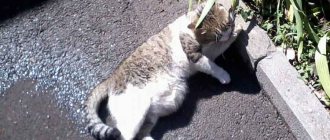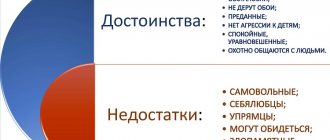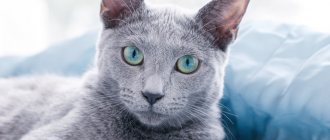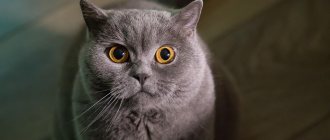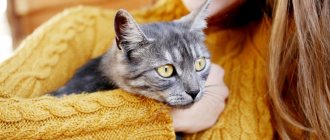Kittens weight
After the baby is born, you can see how strong and big he will grow.
For a newborn British kitten, the normal weight is in the range of 70-130 g. Already in the second week, the kitten can reach a weight of 150 g. In two weeks, the baby grows almost one and a half times, which means that it is the first period of his life that will greatly influence the future sizes.
The main thing is to pay enough attention to nutrition. A cat that feeds growing offspring must be well fed with high-calorie food and vitamins in order to be able to fully feed the kittens with milk.
After the second week, the baby already weighs 210 g - this is the average. However, a kitten can weigh much more - 450 g (upper norm). He becomes more active, his eyes may even open.
At the end of the first month of life, complementary foods can be introduced. It is permissible to feed the baby with boiled and finely chopped beef and canned cat food, sea fish, chicken, cottage cheese (a very useful product for strengthening bones) and hard-boiled eggs (yolks only).
In the first month of development, the kitten should grow to 250 g, although a normal weight is even 600 g. Well, in two months, depending on heredity and nutrition, the kitten will weigh from 700 g to 1.5 kg.
Over the course of three months of life, the kitten must gain at least 1 kg of weight. If not, he may have a health problem or is not getting enough nutrition.
During this period, the kitten can become almost 100 g heavier every day. A cat at this age should weigh in the range of 1-1.5 kg, and a cat - 1.5-2 kg.
If babies are still fed breast milk, they need to introduce vitamins and a more varied diet into their diet. It is not recommended to give them smoked meats, pork and other fatty meats, fatty cottage cheese, river fish and, most importantly, meat with bones. The best option is canned cat food with a good range of vitamins and nutrients.
After 4 months of life, cats gain up to 1.7-2.4 kg, and males - from 2.1 to 3.9 kg. The pet becomes even more like an adult animal. If his weight exceeds 4 kg, it is necessary to reduce the amount of food, since a cat that begins to gain weight at an early age may have many health problems in the future. It may be worth contacting a veterinarian - he will prescribe the right diet and vitamins.
After five months of life, the male cat should weigh 2.6-4.5 kg, and the male cat should weigh 2.2-2.9 kg. Before becoming an adult cat, the pet will have to gain the same amount of mass.
At the sixth month of life, the kitten develops fairly strong teeth. Sexual development begins. It would also be a good idea to think about preventing worms. The quantity and food for kittens can be gradually reduced.
In the seventh month, the pet may shed hair, especially if it spends a lot of time outside. Hairballs appear everywhere, which the kittens regurgitate.
At the eighth month of a kitten’s life, the owner is faced with the question of whether to castrate/sterilize or not. It is better to carry out this procedure for cats at the 8th month, for cats no later than a year.
In the ninth month you need to get vaccinated. They are already sufficiently formed so that medication does not have a detrimental effect on them.
At the tenth month of life, food for adult cats should be introduced into the diet, and the children's menu should be abandoned. Now they can be given dry food.
At the age of 11-12 months of life, kittens begin to play actively, stop creating inconvenience for others and like to often release their claws. The weight of cats at one year of age and in adulthood is given below (castration/sterilization also plays a role).
Table
Why do you need to monitor a kitten’s weight at different periods of its growth?
Despite the large breed and individual characteristics of a kitten, changes in its weight at a certain age can be used to judge whether it is developing correctly. There is a breed standard that sets out weight standards. Deviation in either direction is not acceptable. Of course, a lot depends on the mother's milk supply. Therefore, it is recommended to feed her well.
The calorie requirement of a lactating cat is, on average, 3 times greater than for a pet at rest. Therefore, ad libitum feeding is practiced. To prevent food from spoiling, it is necessary to switch to professional nutrition with dry granules containing the necessary vitamins and other nutrients.
The industry does not produce special food for pregnant and lactating cats. Therefore, they use super premium food for kittens. This approach keeps milk production high and helps the kitten transition from mother's milk to solid food.
The weight of a younger kitten should constantly increase and double by the age of one week. Responsible felinologists weigh a newborn in the first week of life every day at the same hour. Then the frequency of mass determination is reduced and after six months monthly weighing is sufficient. Constant weight gain is considered an indicator of a pet's good health.
Be sure to read:
British cat: character, care and maintenance, sterilization, when to vaccinate, feeding, what diseases they are susceptible to
Kitten owners are concerned about moments when the growth rate drops or stops altogether.
In most cases, this is explained by the following objective reasons:
- Weaning : the transition from mother's milk to solid food requires a restructuring of enzymes.
- Deworming in preparation for vaccination. Dying parasites release toxic metabolic products, poisoning occurs, and growth stops.
- Post-vaccination complications: even if the kitten’s health worsens for a few days, there is no need to worry about it.
- Changing teeth: the pet is in a little pain, food eating decreases.
- Upon reaching six months of age, feed consumption decreases and growth rate decreases. But these are the physiological features of the development of cats.
- Puberty and the first estrus are accompanied by small plumbs.
In addition to physiological reasons for growth inhibition, pathological ones may appear: poisoning, infection or invasion.
Parameters of an adult cat
After the cat has grown and formed, its weight should be from 2.5 to 5.5 kg, and that of the cat - from 4.5 to 8 kg. At this stage of life, weight also depends on “additional” procedures: for example, a sterilized cat can gain up to 6 kg, and a cat can gain up to 9 kg.
British cats reach their adulthood and stop gaining weight at 3-4 years of age. It is worth noting that cats with solid colors tend to have a higher body weight than “patterned” British cats, and this is normal.
You can determine whether a cat has a normal weight by simply feeling it lengthwise: the pet’s subcutaneous layer of fat should be barely noticeable and lightly cover the ribs, which provides good thermal insulation without reducing mobility and activity. The presence of fat in the intercostal spaces indicates that the cat is overweight. It is worth remembering that the British are strong and powerful animals, quite large, but by no means fat.
What are the dangers of gross dietary violations?
Overfeeding can lead to premature wear and tear of the gastrointestinal tract, in particular to problems with the liver and pancreas. The same applies to the use of cheap, low-quality feed, since a cat is not a rooster, it cannot digest, for example, low-quality grain.
An attempt to transfer exotic cats raised on food to bones and other products from the human table will only bring negative results. Such an adventure often ends in the death of these animals - they flatly refuse to eat.
Tips from breeders on how to feed kittens correctly are presented in the video below.
Why is it important to control your pet's weight?
Caring owners must keep a diary of their kittens' weight from the very first days of their life. This allows you to monitor the development of your pet. It is very difficult to control based on visual parameters: that is why the measurement is based on weight. It is recommended to have accurate electronic scales in the house and weigh babies every day in the first weeks of life, and later - at least once a week. The weight of a newborn baby must be at least 60 grams, otherwise you should immediately contact a veterinarian. Such a baby must be fed with special care in the future.
Longhaired British cats
Fluffy Britons were not recognized as a separate species for many years. But at the beginning of the 20th century, the British Longhair was recognized and registered as a new independent breed. Then the breed standard was written down, which is similar to the standard of the short-haired species.
This type of British Shorthair cat has practically no different physique and character. But the main highlight of the breed is the coat - it is thick, long, fluffy, with a well-developed undercoat. The pet’s tail also deserves special attention – it is very fluffy.
Why doesn't the animal gain weight?
During the early stages of life, a kitten should gain weight very quickly, so the owner can easily notice any growth problems, especially compared to other kittens. If the kitten is not growing, you should pay attention to the following reasons:
- In the case of a large litter (more than five kittens), the baby may not have enough mother's milk or even a free nipple. It is worth paying attention to how well and often he eats, and also apply it to his mother’s nipple yourself.
- If all the kittens are actively suckling their mother, but are growing poorly, it is worth increasing the amount of food for the mother, adding vitamins and calories.
- If everything is fine with nutrition, but the kittens are still not gaining weight, they should be taken to the veterinarian
Proper nutrition and a sufficient amount of vitamins are the basis for the normal and rapid development of a pet. If the weight of babies at a certain stage of life differs greatly from the indicators given in the table, you should consult a veterinarian.
Video "British cats"
In this video you will hear interesting facts about British cats.
Recommended Posts
Scottish kitten weight table by month and week
Maine Coon cat weight standard and dimensions
Table of healthy kitten weight by month
Weight of a puppy and an adult Labrador by month
Weight and height of a German Shepherd puppy by month
TOP 25 most fluffy dog breeds in the world: names, descriptions and photos
Care and maintenance
The British woman feels great both in a small apartment and in a private house. Before you decide to buy an animal, look for a secluded place in the house where it will be comfortable and cozy. You can buy a special bed, or you can lay a soft blanket.
Caring for a British cat, be it a short- or long-haired representative, is not difficult. Here you don’t have to spend a lot of time and money to make your pet attractive.
Hygiene
Grooming is considered the main hygiene procedure. For short-haired Britons, it is enough to comb them once a week, for long-haired ones – 2-3 times. But the most important period is molting. Then both of them need daily combing. To do this, you need to purchase a special rubber brush, which more easily removes dead hairs from the thick undercoat.
It is very important to keep your cat's litter box clean and to wash feeding bowls periodically. Ear and eye cleaning is mandatory. Trim nails as needed. If you wish, you can buy a scratching post.
Kitten care
Kittens need more frequent inspection of their ears and wiping their eyes with a cotton pad dipped in boiled water.
Bathing
The British cat does not tolerate water procedures easily and without much pleasure, but washing should be organized at least once a year. When washing, it is important not to wet your head and ears. For bathing, use only special shampoo for soft coats. You cannot dry it with a hairdryer. At the end of the procedures, wet the animal well with a towel.
Caring for British cats is quite simple. Take a few minutes a day to care for your coat and eyes. Trim your cat's claws 2-3 times a month and remove dirt from the ears.
We suggest you read: Lameness in a cat, the main causes of the disease
To make the new family member feel comfortable in the house, it is recommended to purchase all the necessary accessories and toys in advance.
Accessories
- Tray. The British toilet can be either open or closed. It is recommended to purchase a spacious tray with filler.
- Bowl for food. For British cats, any bowl with a wide bottom is suitable.
- Water bowl. The drinking bowl should be large. A dog bowl works great.
- Comb. A metal brush with sparse and rounded teeth will be just right for a Briton.
- Sleeping area. A cat house is perfect for a British kitten, where he can play, sleep and even sharpen his claws.
Grooming
The plush fur coat of the British Shorthair, combined with its elegant appearance, is distinguished by its unpretentiousness.
You should wash your pet only if it is very dirty - such cats take excellent care of themselves on their own.
During the shedding period, it is enough to remove excess fur with a damp rubber mitten.
But a British cat needs to be brushed at least 2 times a week. If possible, spray the fur with an antistatic agent before combing, and then thoroughly massage along the back and sides. As a rule, British women really like the procedure itself.
Character
Representatives of the British cat breed love tranquility. They have a friendly and gentle character. However, the British do not like to be held - they often decide for themselves how much they can be stroked and held in their arms. However, the cat’s peculiar habits do not prevent him from being a devoted friend of his owner.
Even in the event of a conflict, British cats are not aggressive - they do not bite or scratch.
They love to play and catch mice in the house.
| Character | Calm, friendly |
| Suitable for home | Fits good |
| Tolerates loneliness | Well tolerated |
| Postpones the move | Doesn't tolerate well |
| Street | Not afraid, can stay in nature for a long time |
| Relationship with the owner | Chooses one owner |
| Relationship with children | Gets along well |
| Relations with guests | Gets along well |
| Relationship with other cats | Gets along very well |
| Relationship with dogs | Gets along well |
The character and habits of British cats {amp}gt;{amp}gt;
To prevent a British cat from developing bad habits, it must be trained from an early age. This breed is fairly easy and quick to train, so there shouldn’t be any problems. When you catch a kitten at the “crime scene,” try to tell him command words in a firm voice.
We invite you to familiarize yourself with: American Bobtail cats and male cats
Moreover, it is better if these are pre-prepared, short and sonorous phrases that you will repeat every time if the situation repeats. Simultaneously with the words, show the kitten the action that he needs to perform. Thus, raising a Briton will be brilliant by the age of 2!
The British cat is endowed with good manners from birth. She is sociable, but at the same time she will not impose herself and can calmly sit alone.
What is special about representatives of this breed:
- They, like true English aristocrats, rarely allow themselves to run and frolic around the apartment in vain. The cat prefers to move smoothly and impressively around the room, without creating unnecessary noise.
- Too active games are not for them, as the British quickly get tired and lose interest in new fun.
- They are characterized by intelligence. The cat will obediently wait to be petted, and only then will it try to free itself carefully and unnoticed.
- British cats are not annoying and will not make noise at night, demanding food or attention. The pet can calmly wait until the morning while you sleep.
- They are very neat. It seems that such cleanliness is in their blood. After all, even small kittens try to go to the litter box as soon as they learn to walk.
- The animal easily tolerates loneliness. They are not bored in an empty apartment, but they are always happy to greet the owner at the door.
- Despite the fact that these cats try to prove themselves as independent and independent members of the family, they still need affection, communication and attention. But only when they themselves want it.
- This is a very smart and wise animal that can easily adapt to the atmosphere in the house. The pupil also follows the rules dictated by the owner.
- The pet gets along easily with other animals and gets along with children. If conflicting circumstances arise, the cat simply leaves and sits in another room.
If you find an approach to your furry pet and raise it correctly, then it will not cause any problems.

